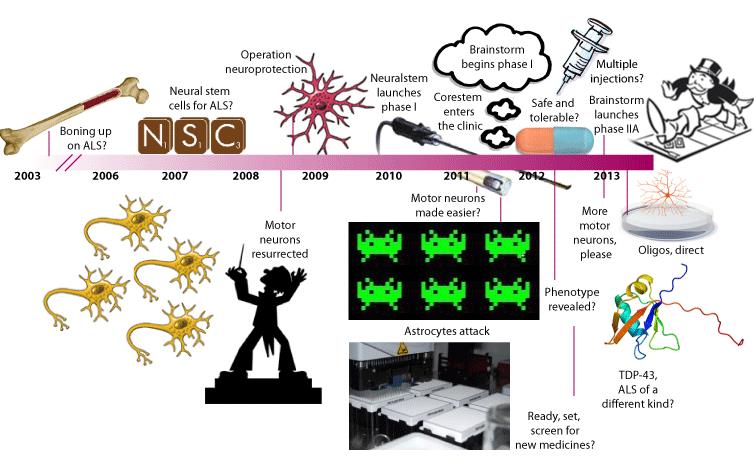
More than 50% of motor neurons degenerate before people with ALS show the first signs of disease. And, more than 70% of motor neurons by some estimates are lost about one year after being diagnosed.
To stem the tide of motor neuron destruction, a growing number of scientists are turning to stem cells in hopes to treat ALS. The strategy deploys cellular armies that aim to protect the motor nerves from further damage due to the disease. The approach, which involves injections of certain cellular precursors, seeks to reduce motor neuron loss by boosting levels of protective substances (neurotrophins) or by detoxifying the nervous systems.
Clinical trials are ongoing. Brainstorm’s NurOwn is at phase IIA. Corestem’s HYNR-CS is at phase I/II. Neuralstem hopes to begin phase II testing as early as this summer. And, Q Therapeutics’ glial-based strategy is expected to file an IND for phase I testing sometime next year.
In the meantime, scientists are using stem cells to create cellular models of ALS. Motor neurons can now be recreated from people with the disease. Key signs of ALS are beginning to be detected. Now, scientists hope to use these models to understand why motor neurons fail in people with ALS. And, discover potential drugs for the disease.
Ahead of the 2013 meeting of the International Society of Stem Cell Research (ISSCR), ALS Today takes a look back at stem cells in ALS in an interactive timeline. Click on the timeline to find out about key advances and key challenges going forward.
***
To learn more about the latest advances in stem cells in ALS, check out SfN12: ALS on the Bayou. To learn more about the challenges of bringing stem cells in the clinic, check out Neuralstem: surging immunosuppression?
References: Emerging Therapies
Mazzini, L., Fagioli, F., Boccaletti, R., Mareschi, K., Oliveri, G., Olivieri, C., Pastore, I., Marasso, R. and Madon, E. (2003) Stem cell therapy in amyotrophic lateral sclerosis: a methodological approach in humans. Amyotrophic Lateral Sclerosis 4(3), 158-161. Abstract | Full Text (Subscription Required)
Xu, L., Yan, J., Chen, D. Welsh, A.M., Hazel, T., Johe, K., Hatfield, G. and Koliatsos, V.E. (2006) Human neural stem cell grafts amerliorate motor neuron disease in SOD-1 transgenic rats. Transplantation 82(7), 865-875. Abstract | Full Text (Subscription Required)
Lepore, A.C., Rauck, B., Dejea, C., Pardo, A.C., Rao, M.S., Rothstein, J.D., and Maragakis, N.J. (2008). Focal transplantation-based astrocyte replacement is neuroprotective in a model of motor neuron disease. Nature Neuroscience, 11(11), 1294-1301. Abstract | Full Text
Hefferan, M.P., et al. (2012) Human neural stem cell replacement therapy for amyotrophic lateral sclerosis by spinal transplantation. PLoS One 7(8), e42614. Abstract | Full Text
Glass, J.D., Boulis, N.M., Johe, K., Rutkove, S.B., Federici, T., Polak, R., Kelly, C. and Feldman, E.L.(2012) Lumbar intraspinal injection of neural stem cells in patients with ALS: results of a phase I trial in 12 patients. Stem Cells, doi:10.1022/ stem.1079. Abstract | Full Text (Subscription Required)
References: iPS, underlying mechanisms and identifying new medicines
Dimos, J.T. et al. (2008) Induced pluripotent stem cells generated from patients with ALS can be differentiated into motor neurons. Science 321, 1218-1221. Abstract | Full Text (Subscription Required)
Son, E.Y., Ichida, J.K., Wainger, B.J., Toma, J.S., Rafuse, V.F., Woolf, C.J. and Eggan, K. (2011). Conversion of mouse and human fibroblasts into functional spinal motor neurons. Cell Stem Cell, 9(3), 205-218. Abstract | Full Text (Open Access)
Haidet-Phillips, A.M. et al. (2011) Astrocytes from familial and sporadic ALS patients are toxic to motor neurons. Nature Biotechnology,29(9), 824-8. Abstract | Full Text (Subscription Required)
Egawa, N. et al. (2012) Drug screening for ALS using patient-specific induced pluripotent stem cells. Science Translational Medicine 4(145), 1-8. Abstract | Full Text (Subscription Required)
Bilican, B. et al. (2012) Mutant induced pluripotent stem cell lines recapitulate aspects of TDP-43 proteinopathies and reveal cell-specific vulnerability. Proceedings of the National Academy of Sciences, doi:10.1073/ pnas.1202922109. Abstract | Full Text (Open Access)
Serio, A. et al. (2013) Astrocyte pathology and the absence of non-cell autonomy in an induced pluripotent stem cell model of TDP-43 proteinopathy. Proceedings of the National Academy of Sciences 110(12), 4697-4702. Abstract | Full Text
Amoroso, M.W. et al. (2013) Accelerated high-yield generation of limb-innervating motor neurons from human stem cells. Journal of Neuroscience 33(2), 574-86. Abstract | Full Text
Najm, F.J., Lager, A.M., Zaremba, A., Wyatt, K., Caprariello, A.V., Factor, D.C., Karl, R.T., Maeda, T., Miller, R.H. and Tesar, P.J. (2013) Transcription factor-mediated reprogramming of fibroblasts to expandable,myelinogenic oligodendrocyte progenitor cells. Nature Biotechnology 31(5), 426-433. Abstract | Full Text (Subscription Required)
Yang, N., Zuchero, J.B., Ahlenius, H., Marro, S., Ng, Y.H., Vierbuchen, T., Hawkins, J.S., Geissler, R., Barres, B.A. and Wernig, M. (2013) Generation of oligodendroglial cells by direct lineage conversion. Nature Biotechnology 31(5), 434-439 Abstract | Full Text (Subscription Required)
Further reading
Cashman, C.R. and Lazzerini Ospri, L. (2013) Induced pluripotent stem cells and motor neuron disease: toward an era of individualized medicine. Journal of Neuroscience 33 (20), 8587-8589. Abstract | Full Text (Subscription Required)
Boulis, N.M., Federici, T., Glass, J.D., Lunn, J.S., Sakowski, S.A. and Feldman, E.L. (2012) Translational stem cell therapy for amyotrophic lateral sclerosis. Nature Reviews Neurology 8(3), 172-176. Abstract | Full Text (Subscription Required)